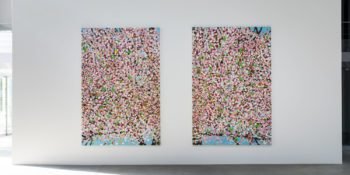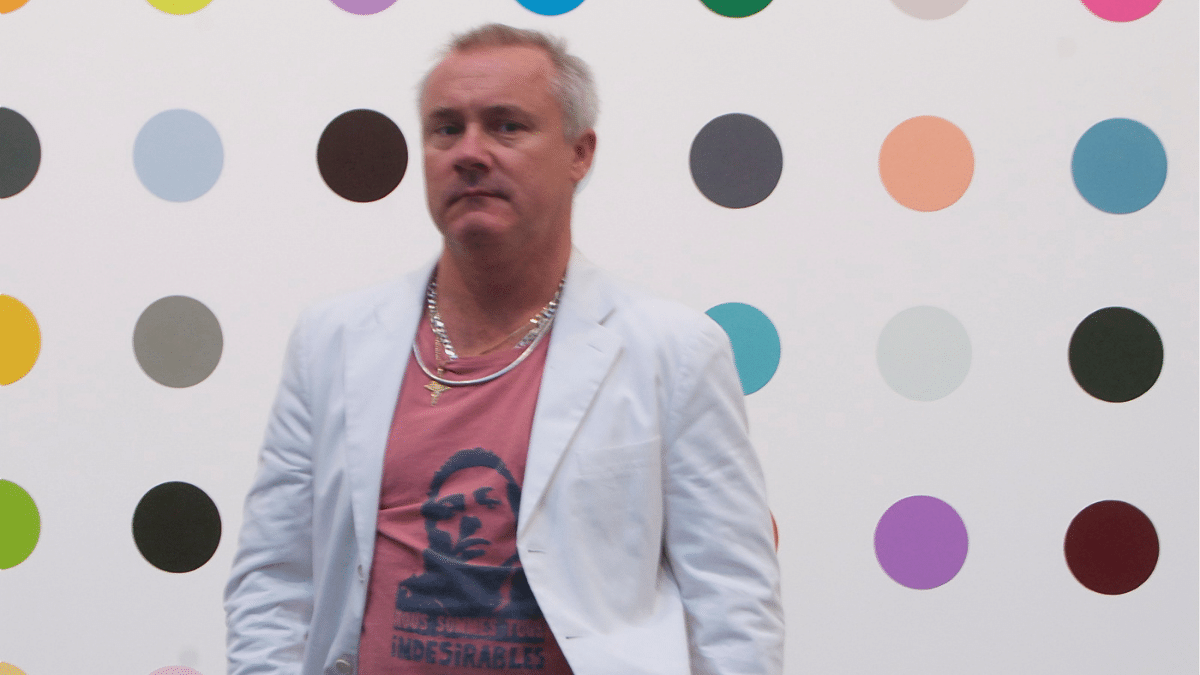The Bizarre Career of Damien Hirst

In July 2021, artist Damien Hirst debuted his latest exhibit, a collection of 107 paintings (30 of which were on display) of cherry blossoms. For Hirst, this was a major moment in his career and one that he took a great deal of pride in.
However, last week, another UK-based artist, Joe Machine, came forward to accuse Hirst of ripping off his earlier works.
According to Machine, Hirst’s painting were so similar to his that he thought he was looking at his own work. Though he clarified that they were not “direct copies”, he claimed there were similarities in style, color choices and techniques used that were overwhelming to him.
Machine has made and displayed his cherry blossom paintings since 2006 and this includes the Walker Gallery in Liverpool, a gallery that Hirst has been featured at as well.
On the surface, this would be an easy case to dismiss. Two artists had similar ideas for a series and executed them in very similar ways.
However, Hirst is not an ordinary artist. Hirst, by his own admission, is a plagiarist and has faced more than a dozen credible accusations of it over his career. Despite this, he has had significant success in the art world, building a career that spans four decades and regularly sells paintings for millions of dollars.
A Successful Career Defined by Plagiarism
Hirst’s career dates back to the late 1980s. Between then and the early 1990s, he bagn to establish hmself as one of the biggest names in the UK art scene, breaking out in the early 1990s as part of the Young British Artists exhibition.
His most famous work was a series of dead animals that were preserved, dissected and posed for display. This included his best-known work, The Physical Impossibility of Death in the Mind of Someone Living, a 1991 piece that featured a preserved tiger shark.
Since then he has tackled a wide variety of projects and has enjoyed steady success with him. However, that doesn’t mean that he’s been without his strong detractors.
In 2010, artist Charles Thomspon compiled a list of 15 separate plagiarism allegations against Hirst and published them in the art magazine Jackdaw. The stories were as varied as Hirst’s career.
In 2000, Hirst was sued by a toy manufacturer over a sculpture he made that resembled a toy that they sold. Hirst paid an undisclosed sum to settle the case.
In 2006, he was accused by a graphic artist, Robert Dixon, of plagiarizing elements of Valium from his Dixon’s work. Hirst’s manager attempted to defend him by claiming the inspiration was from a different book, even though that book also featured Dixon’s work.
The list simply kept growing with more and more credible claims against Hirst.
Hirst, for his part, never seemed that bothered by the accusations. In a 2018 interview, he openly admitted that “All my ideas are stolen anyway,” which many of his fellow artists saw as an open confession to plagiarism.
Despite this history and this admission, Hirst’s work remains extremely valuable. According to reports, Hirst’s cherry blossom paintings sold for up to £2.5 million ($3.41 million) while Machine’s sell for up to £10,000 ($13,600).
This raises a simple question: How is this possible. How has an admitted plagiarist not only had a such a lengthy career but built up an estimated net worth of over $300 million? The answer is in the art industry itself.
A Different Kind of Industry
Journalists, authors, musicians and filmmakers may all work in very different fields, but they have one key thing in common: They’re work is for a mass audience.
If a journalist or a novelist commits the act of plagiarism, they have to answer not just to their editors, but to their audience. People, in general, are disappointed when they learn that creators are lying to them. This, usually, harms their career and at least sets them back.
Though there are exceptions, your average musician, author or filmmaker can’t get away with repeated plagiarism because the audience will eventually leave them for other, more original, creators.
The art world, however, is not one that is accessible to the masses. Simply put, the price of fine art means that it is limited to a small number of collectors.
This market has been described repeatedly as a scam. Buyers purchase art not for enjoyment or viewing, but as either investments or tax shelters. Because of this, they have a huge financial incentive not just in the work, but in the artist.
Collectors work to keep the value of an artist’s work high, so their investments gain value over time. This makes the art world very susceptible to someone like Hirst.
Hirst became a huge name in the UK art scene in the 1990s. His name alone means that his work commands high dollar amounts on the market, and those that have invested in him have every incentive to make sure it stays that way: Plagiarism or not.
Hirst can continue to rake in millions despite his transgressions because the people who are buying aren’t concerned about those transgressions. They care about the value of their investments.
Simply put, the art market is a small, highly concentrated market that values the cache of the artist over their originality.
As long as an artist like Hirst doesn’t copy so significantly as to run afoul of copyright law (while targeting someone with the resources to fight back), they’re usually given a pass. However, even if they do infringe copyright and are successfully sued, often the settlement amount or the damages is miniscule compared to what they were able to earn.
We’ve seen this before with artists like Richard Prince, as artists have been decried for their use of others’ material publicly, but have still found significant financial success on the art market.
Simply put, the art market is a haven for plagiarists, as long as they are able to first become one of the artists that the market values.
Bottom Line
When it comes to the impact plagiarism has on a plagiarist’s career, the decision is ultimately up to those that make up their audience and those that control the money. In the case of the art market, those two entities are largely the same.
The art market simply doesn’t value originality and has no real incentive to do so. The system isn’t designed to punish plagiarism and likely won’t since it would also punish the earlier investors.
It’s a sad, frustrating tale. It makes the art market ripe for plagiarists if they can secure their place in the upper tiers of it. Behavior that would not be acceptable at your local art market or nearby university can go unpunished for decades at this level.
Damien Hirst is, for the lack of a better word, bulletproof when it comes to plagiarism. However, the same could be said for every other artist who has reached his stature. It’s just others aren’t so quick to take advantage of it.
Header Image: Andrew Russeth from New York, New York, CC BY-SA 2.0, via Wikimedia Commons
Want to Reuse or Republish this Content?
If you want to feature this article in your site, classroom or elsewhere, just let us know! We usually grant permission within 24 hours.
